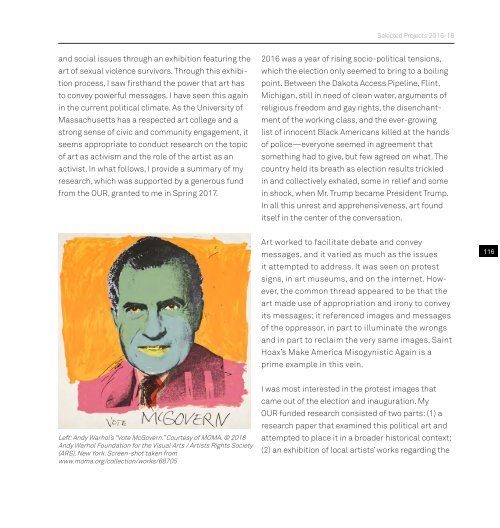Undergrad_Book_16-18_Pge_View_Print_no print marks_compressed
Create successful ePaper yourself
Turn your PDF publications into a flip-book with our unique Google optimized e-Paper software.
Selected Projects 20<strong>16</strong>-<strong>18</strong><br />
and social issues through an exhibition featuring the<br />
art of sexual violence survivors. Through this exhibition<br />
process, I saw firsthand the power that art has<br />
to convey powerful messages. I have seen this again<br />
in the current political climate. As the University of<br />
Massachusetts has a respected art college and a<br />
strong sense of civic and community engagement, it<br />
seems appropriate to conduct research on the topic<br />
of art as activism and the role of the artist as an<br />
activist. In what follows, I provide a summary of my<br />
research, which was supported by a generous fund<br />
from the OUR, granted to me in Spring 2017.<br />
20<strong>16</strong> was a year of rising socio-political tensions,<br />
which the election only seemed to bring to a boiling<br />
point. Between the Dakota Access Pipeline, Flint,<br />
Michigan, still in need of clean water, arguments of<br />
religious freedom and gay rights, the disenchantment<br />
of the working class, and the ever-growing<br />
list of in<strong>no</strong>cent Black Americans killed at the hands<br />
of police—everyone seemed in agreement that<br />
something had to give, but few agreed on what. The<br />
country held its breath as election results trickled<br />
in and collectively exhaled, some in relief and some<br />
in shock, when Mr. Trump became President Trump.<br />
In all this unrest and apprehensiveness, art found<br />
itself in the center of the conversation.<br />
Art worked to facilitate debate and convey<br />
messages, and it varied as much as the issues<br />
it attempted to address. It was seen on protest<br />
signs, in art museums, and on the internet. However,<br />
the common thread appeared to be that the<br />
art made use of appropriation and irony to convey<br />
its messages; it referenced images and messages<br />
of the oppressor, in part to illuminate the wrongs<br />
and in part to reclaim the very same images. Saint<br />
Hoax’s Make America Misogynistic Again is a<br />
prime example in this vein.<br />
1<strong>16</strong><br />
Left: Andy Warhol’s “Vote McGovern.” Courtesy of MOMA. © 20<strong>18</strong><br />
Andy Warhol Foundation for the Visual Arts / Artists Rights Society<br />
(ARS), New York. Screen-shot taken from<br />
www.moma.org/collection/works/68705<br />
I was most interested in the protest images that<br />
came out of the election and inauguration. My<br />
OUR funded research consisted of two parts: (1) a<br />
research paper that examined this political art and<br />
attempted to place it in a broader historical context;<br />
(2) an exhibition of local artists’ works regarding the



